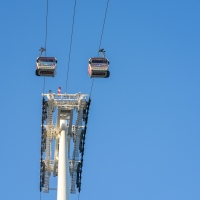
Greenfinch watching over its nest from above, St Albans, April 2021
Now over to all of you. Do come and join us in our Saturday six-word musings.
I’ll admit that many of us openly break the numeric rule and share far more words (all excellent of course!) so the key rule is to have a title of six words – and then create around that the post that you desire! Perhaps in bunches of 6 words if you’re feeling inspired.
To join the challenge, please put a link in your post to the URL of this post. Then come back here and leave us a comment. If you have any problems with linking, just put your own URL into the comment. And do feel free to socialise digitally – tweet, instagram, flickr, etc. with the hashtags #SixWordSaturday and #6WS.

Copyright Debbie Smyth, 17 April 2021
Posted as part of Six Word Saturday
…






A lovely visitor! And a great shot too!
LikeLiked by 1 person
A stunning photo, Debbie! Lord and master over the garden, and ferocious protector.
LikeLiked by 1 person
Yes, it’s great seeing him keep watch over mum and the nest
LikeLiked by 1 person
Such a pretty finch! Here’s mine for this week. https://www.irenetron.net/thorns-wispiness-and-things-in-between/
LikeLiked by 1 person
Beautiful shot! https://fakeflamenco.com/2021/04/17/1-bright-squirrels-hiding-place/
LikeLiked by 1 person
I’d welcome a bird like that to my garden but alas, fat pigeons have chased away all my song-birds and eaten all the seeds and fats left out for the smaller birds. I had a couple of wonderful blackbirds coming to serenade me every morning on my balcony but now when I pull my curtains I’m Greeted by the beady eye of a pigeon surfeited on other birds’ food. From today, I stop leaving it out.
LikeLiked by 1 person
Same problem here. I got a bird table with a low roof but the pigeons still managed to get in. No I’ve added more pieces of wood to narrow the openings and the pigeons are blocked :). But the squirrels still get in!
LikeLike
Oh what a welcome visitor. So beautiful 😀
LikeLiked by 1 person
I love finches of all types!
Here’s my 6WS: https://outofmywritemind.com/2021/04/17/the-daffodils-were-super-this-year/
LikeLike
Lovely capture.
LikeLike
Yours a bit prettier than mine…https://lagottocattleya.wordpress.com/2021/04/17/and-the-wrinkled-rhubarbs-finally-arrived/
LikeLike
I love goldfinch and used to see lots of them in the park in Illinois. It’s hard to get close to them when they’re actually sitting so good job and excellent photo.
janet
LikeLike
No greenfinches here in Cornwall that I have seen. Sad to read about the disease and their decline.
LikeLike
Beside nest watching, this fella is also enjoying the scenery I’m sure 🙂
LikeLike
😀I think he is. He’s also been getting a fair ride as the wind blows the branches around
LikeLiked by 1 person
Isn’t that wonderful to have a new bird come into your garden Debbie 🙂 🙂
LikeLike
In fact, there’s a female too. They fly around together 🙂
LikeLiked by 1 person
Even better Hope they nest nearby 🙂
LikeLiked by 1 person
cute picture…sàn gỗ
LikeLike
Ah, what a lovely sight in your garden, and great capture! I’m in the natural world too: https://suejudd.com/2021/04/17/spring-is-pink-blossom-and-daffodils/
LikeLike
Pretty bird – and less than half the size of mine, today: https://picturesimperfectblog.wordpress.com/2021/04/17/what-do-you-mean-puff-daddy/
LikeLike
He’s a pretty one! Beautifully caught on camera 🙂 🙂
I’m still dwelling in the past! https://restlessjo.me/2021/04/17/six-word-saturday-402/
LikeLiked by 1 person
Well spotted: He’s posing nicely. I’m doing the natural world too – the tamed variety: https://margaret21.com/2021/04/17/bright-and-beautiful-new-born-lambs/
LikeLiked by 1 person
A great close up – here’s mine!
https://travelswithali.com/2021/04/17/pull-up-a-bright-blue-seat/
LikeLiked by 1 person
One of the European finches that’s not as common as it was. Another simple one from me this week:
https://davidmsphotoblog.com/2021/04/17/moss-and-lichen-on-tree-bark/
LikeLiked by 2 people
I e never seen one in my garden before. There’s a pair of them nesting in a bush 🙂 the female is harder to catch
LikeLiked by 2 people
I seem to think that there’s a disease that’s dramatically reduced the population although I can’t remember the details.
LikeLiked by 1 person
I’ve looked it up now. You’re right: “Greenfinch populations declined during the late 1970s and early 1980s, but increased dramatically during the 1990s. A recent decline in numbers has been linked to an outbreak of trichomonosis, a parasite-induced disease which prevents the birds from feeding properly.”
LikeLike
Yes. I seem to think that trichomonosis started hitting the population mid 2000s. I was living in Canada by then but heard reports from friends and family about the population decline. They were a common bird in Cheshire in the 1980s and 1990s.
LikeLike
Fantastic capture, Debbie 😃 Here’s mine: https://jezbraithwaite.blog/2021/04/17/reflections-revealed-as-the-mist-dissipates/
LikeLiked by 1 person
We have a lot of green finches visiting our garden during the winter. Now they moved on to the forrest.
LikeLiked by 2 people
Gorgeous little birds… we don’t seem to get any of them here in Cheshire, Debbie, although I suppose they could keep themselves well hidden.
My post this week is looking at things perhaps a little more darker…
https://wp.me/pVkLb-5mj
LikeLiked by 2 people
RSPB say they are common in our gardens all over the country. And they gather in herds in parks and the like in winter to hunt for food. But this is the first time I e seen any around here. I reckon they hide well!
LikeLiked by 1 person
I shall keep my eyes peeled from now on! 🙂
LikeLike